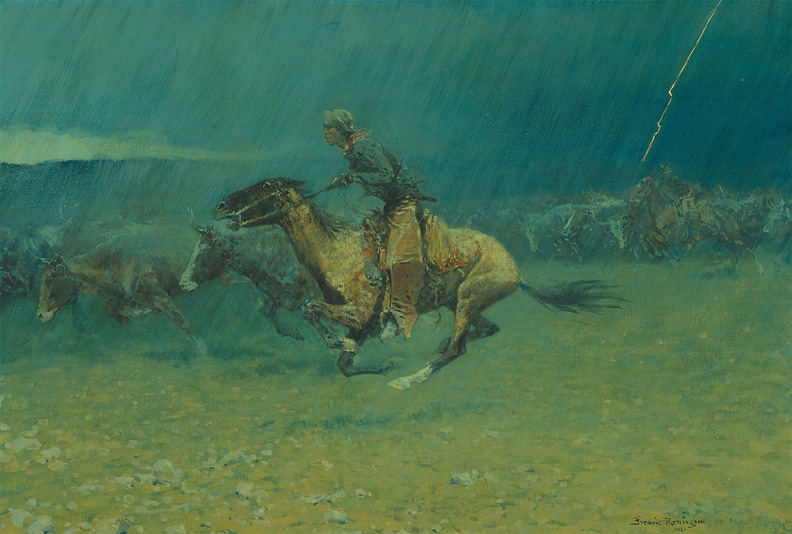Agriculture in Art
Frederic Remington
 The Stampede, 1908
The Stampede, 1908
 The Stampede, 1908
The Stampede, 1908
Frederic Sackrider Remington (October 4, 1861 - December 26, 1909) was an American painter, illustrator, sculptor, and writer. As a young man, he traveled widely throughout the country, spending most of his time sketching the people and places in the new American frontier. In 1886 he established himself as an illustrator of Western themes, and sold his work to many of the major magazines of the time including, Harper's Weekly. While most of his best known work was in illustration, he was also a fine painter, capturing on his canvases the sweeping vistas, heroic figures, and moments of danger and conflict that came to define the archetypal romance of the West.
By 1900 Remington had begun to experiment with impressionism. The Stampede was painted during this period. His painting at this time showed a rejection of the crisp linear illustrator style he had used previously. Instead he began to concentrate on mood, color and light - sunlight, moonlight, and firelight. This painting is part of the permanent collection at the Gilcrease Museum in Tulsa.
Activities
- Make a list of adjectives to describe this painting.
- What details does the artist use to show movement?
- Identify the horizontal and vertical lines.
- What is the dominant color?
- What other colors does the artist use? What effects do the different colors have?
- What is the center of interest? What is in the background?
- Where is the light? Where is the shadow?
- How does the artist make us see which objects are in the foreground and which are in the background?
- What does this painting tell us about cattle drives and the American West?
- Remington was known for romanticizing the Old West - making it appear more glamourous than it really was. What do you see in this painting that might be an example of this tendency?
- Write and share stories about this painting.
More Resources
More about Frederick Remington
- A Mexican Vaquero, 1890
He knew the men, he knew the horses, too;
The swarthy, silent trapper, all alone,
The cowman--and he knew what they could do.
The range to him was an open book;
The peaks and crags and hills--he knew them well;
He knew the secrets in each canyon brook,
And what the great plains whispered he could tell.
It glowed with all the colors of the West;
His paint-tubes told the horrors of the strife--
The charge, the savage warwhoop and the rest.
He showed the white-topped wagons, jolting on;
The grim and hardy plainsmen as they rode;
The campfire in the gray of early dawn;
The pack-train with its lashed and swaying load.
He drew them with a keen and master hand;
He saw and saved to us the West before
There passed the remnants of that valiant brand.
He gave to us the cowboy--carefree, brave;
The riders of the range he pictured true;
'Twas left for him their herds and them to save,
Ere they had passed forever from our view.
Whose brush so deftly told its every tale;
The horses and teh men he loved best,
When he, too, rode the dusty cattle trail.
A shaft to him whose canvas gleams and glows
with colors of the life he loved so well;
And from whose painted pictures ever flows
A charm which weaves o'er us a magic spell!
A. A. Brininstool, Trail Dust of a Maverick, 1914
